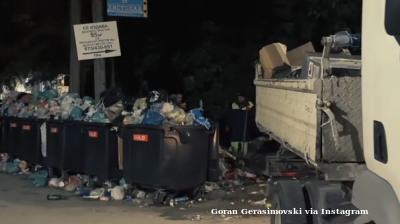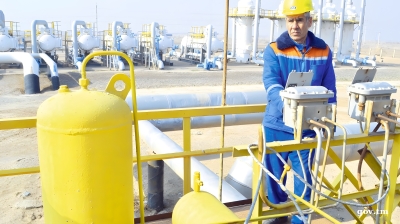Every week, a new hole appears in the ground in Tehran. On November 2, as a asphalt truck trundled along Shahrdari Street in Tehran's northern Saadatabad neighbourhood, the ground simply gave way beneath its rear wheels. The lorry tipped precariously into a freshly opened void. This was the latest incident in a series of events in recent years across the metropolis, symptoms of a water emergency that has accelerated in recent years.
The capital, home to more than 8mn people, hasn't seen meaningful rainfall for 200 days. The last proper rain fell in early May. With over 40 autumn days elapsed and still no downpours, local meteorologists are warning that significant rainfall is unlikely before December. This is probably a new record, and not a good one.
"We are now entering our sixth year of drought," announced Energy Minister Abbas Ali Abadi during the inauguration of water and power projects on November 3, according to IRNA. His words carried an unmistakable warning. "We ask that people continue their cooperation in the optimal use of water as long as this low-rainfall situation persists. We have issued warnings to heavy consumers, and we will disconnect them."
It's a threat born of desperation. Tehran's water crisis isn't simply about absent rain, though that's bad enough. It's about decades of chaotic urban expansion, unregulated groundwater extraction, and infrastructure so decrepit that hundreds of millions of cubic metres vanish before reaching a single tap.
The great water transfer
Consider the case of the Taleghan Dam, nestled in the Alborz mountains northwest of Tehran. Conceived as a lifeline for the parched capital, it's connected to treatment plants in Tehran and neighbouring Alborz province via a 62-kilometre pipeline. On paper, it should deliver 150mn cubic metres of water annually to 3mn residents. In practice, it's haemorrhaging resources on an epic scale.
Ali Haddadi, secretary of the parliament's Industries and Mines Commission, revealed the shocking extent of the loss during a recent economic development ceremony. "While tens of billions of rials are spent transferring water from Taleghan Dam to Tehran, more than 500mn cubic metres of water is wasted annually in this very stretch," he was quoted as saying by Mehr news agency. "If we prevent this wastage, a major portion of the province's water problems will be resolved."
Half a billion cubic metres. To put that in perspective, it's enough to supply a city of 2mn people for an entire year. And it's simply disappearing: leaked through ageing pipes, lost to evaporation, siphoned off illegally, or squandered through sheer administrative incompetence.
The minister's solution? A brand-new pipeline, completed in under eight months with help from the Khatam-al-Anbiya Construction Headquarters (an engineering arm of the Revolutionary Guards). The two-metre-diameter replacement line, stretching 62 kilometres at a cost of IRR767 trillion (roughly $700bn), promises to secure drinking water for 3mn people, enable maintenance of the existing decrepit line, allow simultaneous use during emergencies, and deploy up-to-date technology using domestically produced equipment.
It's an impressive feat of engineering. But it's also an admission that the old system had become so dysfunctional that building an entirely new one was preferable to fixing what existed. And it does nothing to address the underlying problem: Tehran is using far more water than nature can replenish.
When the earth caves in
The consequences are literally visible in the streets. The Saadatabad incident was far from isolated. Mohammad Aghamiri, a member of Tehran City Council and chair of its Development and Infrastructure Commission, has been sounding the alarm for months. In a conversation with Ana news agency, he outlined the scale of the subsidence crisis.
"In some areas of Tehran, the rate of subsidence has reached more than 20 centimetres per year, several times the global critical threshold of four millimetres annually," Aghamiri warned. "This causes irreparable damage to underground aquifers, and if left uncontrolled, will expose urban infrastructure to serious danger."
Twenty centimetres is the height of a standard house brick, vanishing from beneath the capital every year. The cause is straightforward: when you pump out groundwater faster than rainfall can replace it, the soil compacts. Voids appear. Buildings crack. Roads buckle. And occasionally, lorries tumble into sinkholes.
It's a phenomenon afflicting cities across the world, from Mexico City to Jakarta. But Tehran's situation is particularly acute because of its size, its elevation, and its political importance. When the capital's infrastructure begins to fail, the reverberations are felt nationwide.
Aghamiri isn't just raising the alarm: he's been working on solutions. He revealed that the city council, in collaboration with more than 70 university professors from across Iran, has drafted a comprehensive National Land Subsidence Control Bill. After 11 specialist sessions, the framework was sent to parliament and received preliminary approval from the Research Centre and the Agriculture and Environment Commission in March 2023.
Progress stalled, but resumed in earnest last summer. "In this bill, the duties of all executive bodies, including the Ministry of Energy, the Department of Environment, and others, are specified," Aghamiri explained. "The main secretariat will be based at the interior ministry to oversee implementation at the provincial level."
If enacted, he predicted, initial effects could be visible within three years, with subsidence stabilised nationwide within a decade. It's an ambitious timeline, requiring bureaucratic coordination that Iran's fractious political system has rarely demonstrated. But without it, he warned, the damage will become irreversible.
The politics of parsimony
Tehran's water crisis is as much political as hydrological. Iran's Islamic Republic has long struggled to balance competing demands: agricultural lobbies want cheap irrigation, industries need reliable supply, and urban populations expect taps that actually flow. For decades, the solution was to simply drill deeper. Now the wells are running dry.
President Masoud Pezeshkian's government, still finding its feet after last year's election, faces an unenviable choice. Raising water prices would encourage conservation but risks public anger. Cutting off heavy users sounds decisive but could spark confrontation with politically connected elites. Building new infrastructure takes years and money the treasury doesn't have. Meanwhile, every month without rain pushes the crisis deeper.
The energy minister's threat to disconnect wasteful consumers is politically significant. In Iran, water theft and overconsumption are often tacitly tolerated, particularly amongst the wealthy and well-connected who maintain private wells and lavish gardens. Actually following through would signal that the government recognises the emergency and is willing to spend political capital addressing it.
But threats alone won't make it rain. Iran's meteorological authorities predict the drought will persist well into winter, traditionally the wettest season. Climate models suggest the broader region is shifting towards permanent aridity, part of a pattern that's already turned much of the Middle East into a tinderbox of resource competition.
Tehran wasn't always this thirsty. Photographs from the 1970s show a city of tree-lined avenues and flowing joubs (traditional water channels). The population was 5mn; the climate was semi-arid but manageable. Then came revolution, war, and explosive growth.
The metropolitan area now houses 14mn people (some estimates are higher) in a sprawling concrete expanse that extends up mountainsides and across desert plains.
That growth happened with virtually no water planning. Developers built with abandon. Migrants arrived from drought-stricken rural areas in the southeast, themselves victims of agricultural collapse. The government prioritised cheap bread and petrol over water infrastructure. By the time authorities noticed the aquifers were dropping, it was far too late for easy solutions, and even then the threat of “day zero" when taps run dry, as South Africa experienced in recent years, has not yet hit home in many quarters.
bneGREEN

The Arctic and Antarctica record "off the charts" heat as polar warming accelerates
Parts of both the Arctic and Antarctic have experienced historically high temperatures in recent weeks, with weather stations in East Antarctica recording record-breaking warmth for the month of October, alarming climate scientists.

Giant glacier chunk breaks away in Tajikistan, mountain villages put on alert
Situation serves as reminder that climate crisis threatens to wreak havoc in Central Asian country.

Singapore’s green pivot – headline grabbing but still limited
Forays into offshore wind via regional cooperation with neighbours, and forward-looking bets on hydrogen and low-carbon fuels are making headlines, but the scale required to wean a heavily gas-dependent system off fossil fuels is still daunting.

North Macedonia's Skopje tackles mounting waste and rodent crisis
Locals say the problems in Skopje's Centar municipality worsened during the local election period when political campaigning took precedence over maintenance.




